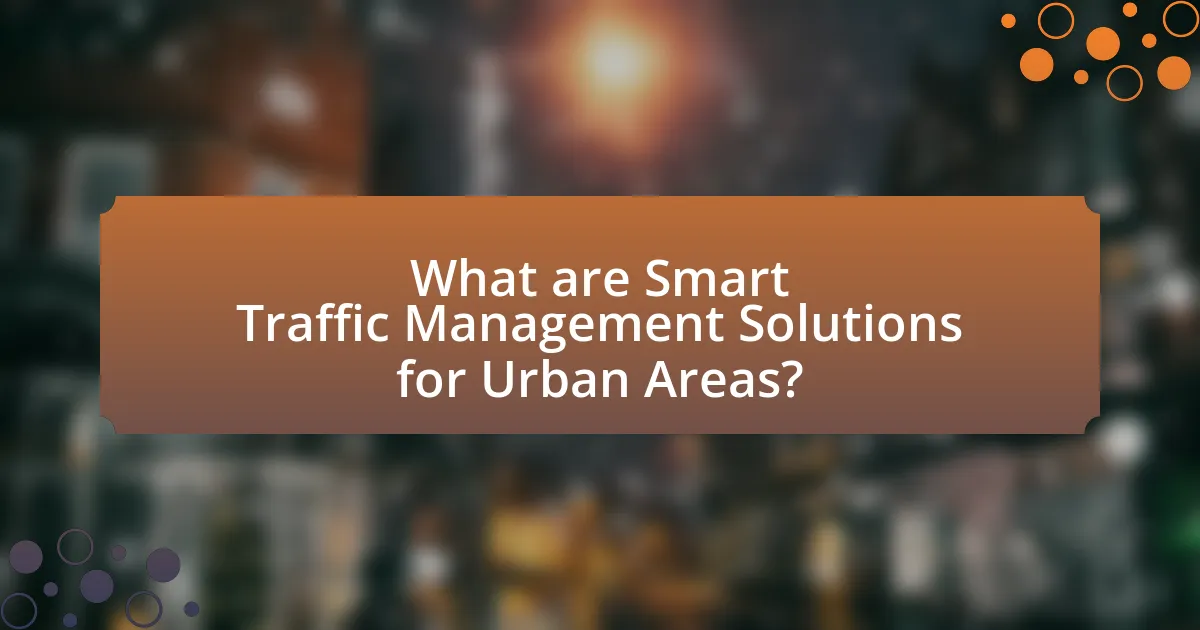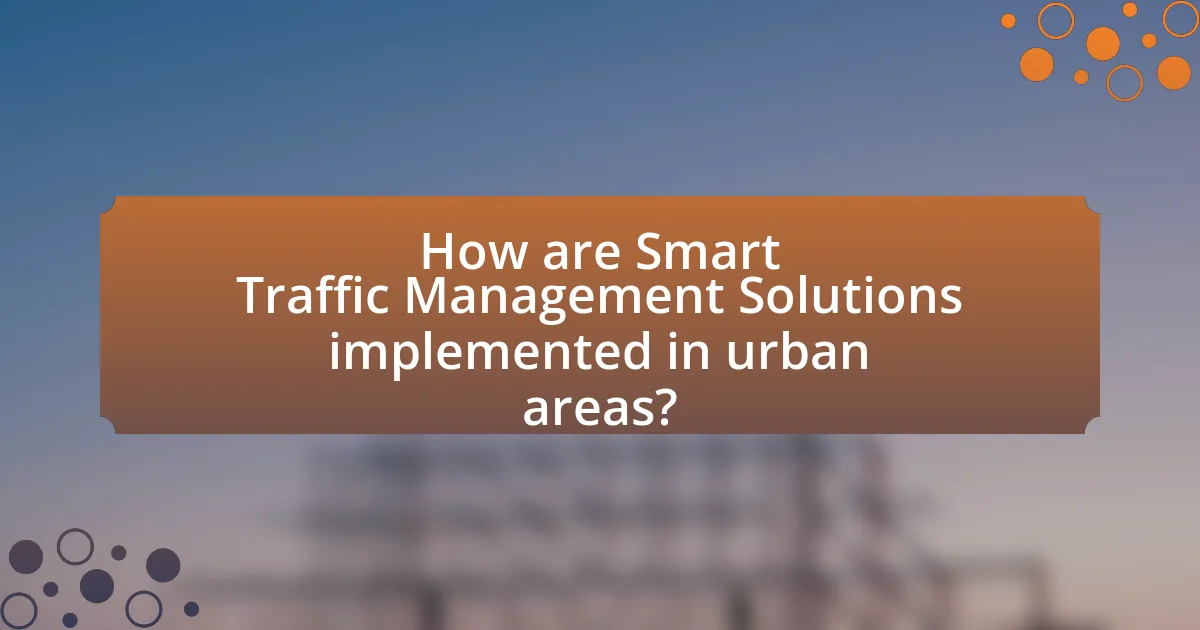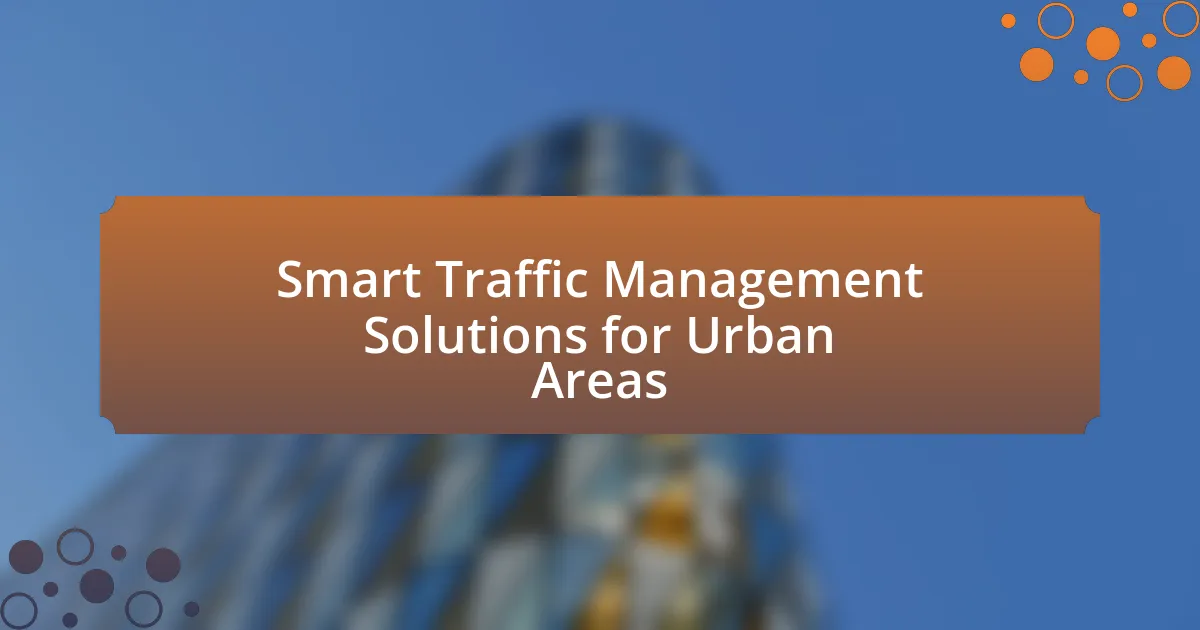Smart Traffic Management Solutions for Urban Areas are advanced systems that utilize technology to optimize traffic flow, reduce congestion, and enhance safety. These solutions incorporate real-time data analytics, adaptive traffic signals, and integrated communication systems to effectively manage vehicle and pedestrian movement. The article explores how these technologies improve urban mobility, the challenges faced in traffic management, and the economic advantages gained from their implementation. It also discusses the role of data in addressing traffic issues, the importance of stakeholder engagement, and future trends shaping smart traffic management, including the impact of artificial intelligence and the Internet of Things.

What are Smart Traffic Management Solutions for Urban Areas?
Smart Traffic Management Solutions for Urban Areas are advanced systems designed to optimize traffic flow, reduce congestion, and enhance safety through the use of technology. These solutions typically incorporate real-time data analytics, adaptive traffic signals, and integrated communication systems to manage vehicle and pedestrian movement effectively. For instance, cities like Los Angeles have implemented smart traffic signals that adjust their timing based on real-time traffic conditions, resulting in a reported 20% reduction in travel times. Additionally, the use of sensors and cameras allows for better monitoring of traffic patterns, enabling proactive management of incidents and improved emergency response times.
How do Smart Traffic Management Solutions improve urban mobility?
Smart Traffic Management Solutions improve urban mobility by optimizing traffic flow and reducing congestion through real-time data analysis and adaptive signal control. These systems utilize sensors and algorithms to monitor traffic patterns, enabling timely adjustments to traffic signals and routing. For instance, cities implementing these solutions have reported reductions in travel times by up to 30% and decreases in vehicle emissions due to less idling. Additionally, studies show that smart traffic systems can enhance public transportation efficiency, leading to increased ridership and improved overall urban mobility.
What technologies are utilized in Smart Traffic Management Solutions?
Smart Traffic Management Solutions utilize technologies such as IoT sensors, artificial intelligence, machine learning, and advanced traffic signal control systems. IoT sensors collect real-time data on traffic flow, vehicle counts, and environmental conditions, enabling dynamic adjustments to traffic signals. Artificial intelligence and machine learning analyze this data to predict traffic patterns and optimize signal timings, improving overall traffic efficiency. Advanced traffic signal control systems integrate these technologies to facilitate smoother traffic flow and reduce congestion, as evidenced by implementations in cities like Los Angeles, where adaptive signal control has led to a 20% reduction in travel time.
How do these technologies interact with existing infrastructure?
Smart traffic management solutions interact with existing infrastructure by integrating advanced technologies such as IoT sensors, data analytics, and adaptive traffic signals into the current urban framework. These technologies enhance real-time data collection and analysis, allowing for improved traffic flow and reduced congestion. For instance, IoT sensors installed on roads and intersections provide continuous feedback on traffic conditions, which can be processed to optimize signal timings. Studies have shown that cities implementing such systems have experienced up to a 30% reduction in travel times and a significant decrease in emissions, demonstrating the effectiveness of these technologies in enhancing existing infrastructure.
What challenges do urban areas face in traffic management?
Urban areas face significant challenges in traffic management, including congestion, inadequate infrastructure, and the integration of technology. Congestion is a primary issue, with studies indicating that urban traffic delays can cost cities billions annually in lost productivity. Inadequate infrastructure, such as insufficient road capacity and outdated traffic signals, exacerbates these delays. Furthermore, the integration of smart technologies, while beneficial, presents challenges in terms of data management, interoperability between systems, and the need for substantial investment. These factors collectively hinder effective traffic management in urban environments.
How do congestion and pollution impact urban traffic systems?
Congestion and pollution significantly impair urban traffic systems by increasing travel times and reducing air quality. Congestion leads to slower vehicle movement, resulting in longer commutes and increased fuel consumption, which exacerbates pollution levels. According to the Texas A&M Transportation Institute’s 2021 Urban Mobility Report, traffic congestion costs the U.S. economy over $166 billion annually in lost productivity and wasted fuel. Additionally, high pollution levels from vehicle emissions can lead to health issues, prompting cities to implement stricter regulations and smart traffic management solutions to mitigate these effects.
What role does data play in addressing these challenges?
Data plays a crucial role in addressing challenges in smart traffic management solutions for urban areas by enabling real-time monitoring and analysis of traffic patterns. This data-driven approach allows city planners and traffic management systems to optimize traffic flow, reduce congestion, and enhance safety. For instance, the use of traffic sensors and cameras generates vast amounts of data that can be analyzed to identify peak traffic times and problem areas, leading to informed decision-making. According to a study by the Institute of Transportation Engineers, cities that implemented data analytics in traffic management saw a 20% reduction in congestion and a 15% decrease in accident rates. This evidence underscores the effectiveness of data in improving urban traffic systems.
What are the key benefits of implementing Smart Traffic Management Solutions?
Implementing Smart Traffic Management Solutions significantly enhances urban mobility and reduces congestion. These solutions utilize real-time data analytics and adaptive traffic signals to optimize traffic flow, leading to a reduction in travel times by up to 30% in some cities. Additionally, they improve safety by decreasing accident rates through better traffic monitoring and management. Studies have shown that cities employing smart traffic systems experience a 20% reduction in traffic-related fatalities. Furthermore, these solutions contribute to environmental sustainability by lowering vehicle emissions, as optimized traffic flow reduces idle times and fuel consumption.
How do these solutions enhance safety for road users?
Smart traffic management solutions enhance safety for road users by utilizing real-time data to optimize traffic flow and reduce congestion. These systems employ technologies such as adaptive traffic signals, which adjust signal timings based on current traffic conditions, leading to fewer accidents caused by stop-and-go traffic. For instance, studies have shown that cities implementing adaptive signal control systems have experienced a reduction in crash rates by up to 30%. Additionally, smart solutions often include features like pedestrian detection and alerts, which further protect vulnerable road users. By integrating these technologies, urban areas can significantly improve overall road safety.
What economic advantages do cities gain from these solutions?
Cities gain significant economic advantages from smart traffic management solutions, primarily through reduced congestion and improved efficiency. These solutions can lead to a decrease in travel time, which, according to the Texas A&M Transportation Institute, saved U.S. drivers approximately $166 billion in 2017 due to reduced congestion. Additionally, optimized traffic flow can lower fuel consumption, resulting in cost savings for both individuals and businesses. Furthermore, enhanced traffic management can increase the reliability of public transportation, encouraging higher ridership and generating additional revenue for transit systems. Overall, these solutions contribute to a more productive urban environment, fostering economic growth and sustainability.

How are Smart Traffic Management Solutions implemented in urban areas?
Smart Traffic Management Solutions are implemented in urban areas through the integration of advanced technologies such as sensors, data analytics, and communication systems. These solutions utilize real-time data from traffic cameras, GPS devices, and mobile applications to monitor traffic flow and optimize signal timings. For instance, cities like Los Angeles have adopted adaptive traffic signal control systems that adjust signal timings based on current traffic conditions, resulting in a reported 20% reduction in travel times. Additionally, smart traffic management systems often include features like incident detection and automated alerts to improve response times for emergencies. The implementation process typically involves collaboration between city planners, technology providers, and transportation agencies to ensure effective integration into existing infrastructure.
What steps are involved in the deployment of these solutions?
The steps involved in the deployment of smart traffic management solutions for urban areas include assessment, planning, implementation, and evaluation. First, assessment involves analyzing current traffic conditions and identifying specific challenges within the urban area. Next, planning entails designing a tailored solution that incorporates technology such as sensors, cameras, and data analytics to address the identified issues. Implementation follows, where the planned technologies are installed and integrated into existing infrastructure. Finally, evaluation assesses the effectiveness of the deployed solutions through data analysis and feedback, allowing for adjustments and improvements to optimize traffic flow and safety.
How is stakeholder engagement managed during implementation?
Stakeholder engagement during the implementation of smart traffic management solutions is managed through structured communication, collaboration, and feedback mechanisms. Project managers establish regular meetings and updates to ensure stakeholders, including local government, community members, and transportation agencies, are informed and involved in decision-making processes. This approach fosters transparency and builds trust, which is essential for successful implementation. For instance, studies have shown that projects with active stakeholder involvement are 30% more likely to meet their objectives, highlighting the importance of engagement in achieving desired outcomes.
What are the common pitfalls to avoid during deployment?
Common pitfalls to avoid during deployment of smart traffic management solutions include inadequate planning, insufficient stakeholder engagement, and lack of data integration. Inadequate planning can lead to misalignment between technology capabilities and urban needs, resulting in ineffective solutions. Insufficient stakeholder engagement often results in resistance from the community and local authorities, which can hinder implementation. Lack of data integration can cause fragmented systems that do not communicate effectively, leading to suboptimal traffic management outcomes. These pitfalls have been observed in various case studies, such as the deployment of smart traffic systems in cities like Los Angeles and Barcelona, where planning and stakeholder involvement significantly impacted the success of the initiatives.
What role do public-private partnerships play in implementation?
Public-private partnerships (PPPs) play a crucial role in the implementation of smart traffic management solutions for urban areas by facilitating collaboration between government entities and private sector companies. These partnerships enable the pooling of resources, expertise, and technology, which enhances the efficiency and effectiveness of traffic management systems. For instance, a study by the World Bank highlights that PPPs can lead to improved infrastructure development and service delivery, as they leverage private sector innovation and investment to address urban traffic challenges. This collaborative approach not only accelerates project timelines but also ensures that solutions are tailored to meet the specific needs of urban environments, ultimately leading to better traffic flow and reduced congestion.
How can collaboration enhance the effectiveness of traffic solutions?
Collaboration can enhance the effectiveness of traffic solutions by integrating diverse stakeholder insights and resources, leading to more comprehensive and adaptive traffic management strategies. When city planners, transportation agencies, technology providers, and the community work together, they can share data and best practices, which improves decision-making and resource allocation. For instance, a study by the Institute of Transportation Engineers found that cities employing collaborative approaches saw a 20% reduction in traffic congestion due to better coordinated traffic signals and real-time data sharing. This collective effort not only optimizes traffic flow but also fosters innovation in developing smart traffic management technologies.
What examples exist of successful partnerships in urban traffic management?
Successful partnerships in urban traffic management include the collaboration between the City of Los Angeles and the University of California, Berkeley, which developed the Adaptive Traffic Signal Control Technology (ATSC). This partnership led to a 20% reduction in travel times and improved traffic flow by using real-time data to adjust signal timings. Another example is the partnership between the City of Barcelona and Cisco, which implemented a smart traffic management system that reduced congestion by 30% through the use of IoT sensors and data analytics. These partnerships demonstrate effective strategies in enhancing urban mobility and reducing traffic-related issues.

What future trends are shaping Smart Traffic Management Solutions?
Future trends shaping Smart Traffic Management Solutions include the integration of artificial intelligence, real-time data analytics, and the Internet of Things (IoT). These technologies enable more efficient traffic flow, reduce congestion, and enhance safety. For instance, AI algorithms can predict traffic patterns and optimize signal timings, while IoT devices collect data from vehicles and infrastructure to inform decision-making. According to a report by McKinsey, cities implementing smart traffic systems can reduce travel times by up to 30% and decrease emissions significantly.
How is artificial intelligence influencing traffic management systems?
Artificial intelligence is significantly influencing traffic management systems by enabling real-time data analysis and predictive modeling. These systems utilize AI algorithms to process vast amounts of traffic data, including vehicle counts, speeds, and congestion patterns, allowing for dynamic traffic signal adjustments and optimized routing. For instance, cities like Los Angeles have implemented AI-driven traffic management solutions that have led to a 20% reduction in travel times and a 10% decrease in emissions, demonstrating the effectiveness of AI in enhancing urban mobility.
What are the implications of AI for real-time traffic analysis?
AI significantly enhances real-time traffic analysis by enabling the processing of vast amounts of data from various sources, such as sensors, cameras, and GPS devices. This capability allows for more accurate traffic predictions, improved congestion management, and optimized traffic signal control. For instance, AI algorithms can analyze traffic patterns and adjust signal timings dynamically, reducing wait times and improving flow efficiency. Studies have shown that cities implementing AI-driven traffic management systems can experience a reduction in congestion by up to 30%, leading to decreased travel times and lower emissions.
How can AI improve predictive traffic modeling?
AI can improve predictive traffic modeling by utilizing machine learning algorithms to analyze vast amounts of traffic data in real-time. These algorithms can identify patterns and trends that traditional modeling methods may overlook, leading to more accurate predictions of traffic flow and congestion. For instance, a study by the University of California, Berkeley, demonstrated that AI-driven models could predict traffic conditions with up to 95% accuracy by integrating data from various sources, including GPS, social media, and historical traffic patterns. This enhanced predictive capability allows for better traffic management strategies, reducing congestion and improving overall urban mobility.
What innovations are emerging in traffic management technology?
Innovations in traffic management technology include the integration of artificial intelligence, real-time data analytics, and connected vehicle systems. These advancements enable cities to optimize traffic flow, reduce congestion, and enhance safety. For instance, AI algorithms can analyze traffic patterns and adjust signal timings dynamically, leading to a reported 20-30% reduction in travel times in urban areas. Additionally, real-time data from sensors and cameras allows for immediate responses to traffic incidents, improving overall efficiency. Connected vehicle technology facilitates communication between vehicles and infrastructure, further enhancing traffic management capabilities.
How do autonomous vehicles impact traffic management strategies?
Autonomous vehicles significantly enhance traffic management strategies by enabling real-time data sharing and communication between vehicles and infrastructure. This capability allows for improved traffic flow, reduced congestion, and optimized routing. For instance, studies indicate that the integration of autonomous vehicles can lead to a 20-30% reduction in traffic delays due to their ability to coordinate movements and respond to traffic conditions dynamically. Furthermore, autonomous vehicles can facilitate the implementation of smart traffic signals that adapt to real-time traffic patterns, thereby increasing efficiency and safety on urban roads.
What role does the Internet of Things (IoT) play in future solutions?
The Internet of Things (IoT) plays a critical role in future solutions for smart traffic management by enabling real-time data collection and analysis from connected devices. This connectivity allows for improved traffic flow, reduced congestion, and enhanced safety through the integration of sensors, cameras, and smart traffic signals. For instance, a study by the International Telecommunication Union highlights that IoT applications can reduce traffic delays by up to 30% by optimizing signal timings based on real-time traffic conditions. Thus, IoT not only facilitates efficient urban mobility but also supports sustainable city planning and management.
What best practices should cities follow when adopting Smart Traffic Management Solutions?
Cities should prioritize data integration and real-time analytics when adopting Smart Traffic Management Solutions. By utilizing a centralized platform that aggregates data from various sources, such as traffic cameras, sensors, and GPS data, cities can enhance decision-making and improve traffic flow. For instance, cities like Los Angeles have implemented such systems, resulting in a reported 12% reduction in travel times. Additionally, engaging stakeholders, including local communities and businesses, ensures that the solutions meet the needs of all users, fostering public support and successful implementation. Furthermore, cities should invest in scalable technology that can adapt to future advancements, ensuring long-term viability and effectiveness of the traffic management systems.
